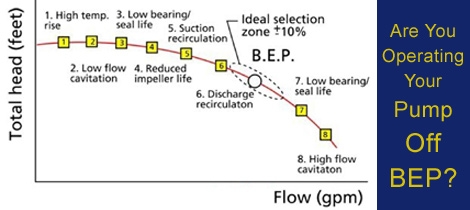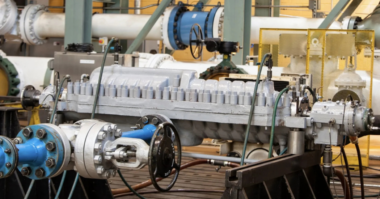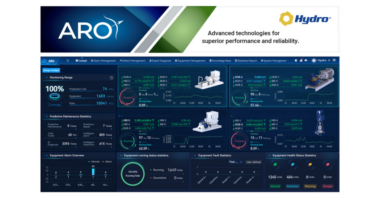Author: Bob Jennings, Hydro Inc.
The Best Efficiency Point, or BEP, is a term that is used quite often in pump vernacular. Like the terms Shut-off (SO) or Run-out (RO), the Best Efficiency Point identifies an operating region or point along the pump performance curve. The Best Efficiency Point is defined as the flow at which the pump operates at the highest or optimum efficiency for a given impeller diameter. When we operate a pump at flows greater than or less than the flow designated by the BEP, we call this “operating pumps away from the Best Efficiency Point”. Therefore, operating a pump at flows higher or greater than the flow at the BEP is called “operating to the right of the BEP”, and conversely, operating a pump at flows lower or less than the flow at the BEP is called “operating to the left of the BEP.”
Under ideal circumstances, a pump will not operate at flows greater than BEP plus 10% or flows less than BEP minus 10%. While we try not to stray too far from the BEP, in general, most pumps operate away from the BEP to one degree or another, and this is acceptable for intermittent duty. There are many consequences, however, to operating your pump too far to the left or right of its Best Efficiency Point for a sustained period of time.
Some of these effects can include:
Cavitation is caused by the formation of vapor bubbles which violently collapse, eroding impeller surfaces and resulting in reduced mean-time-between-repair. Cavitation can occur when operating the pump to the far right of the BEP. For most centrifugal pumps, as the flow increases beyond the BEP, the Net Positive Suction Head required (NPSHr) also increases; and when the NPSHr exceeds the Net Positive Suction Head available (NPSHa), cavitation occurs. Remedies are limited to increasing the NPSHa, which is not always possible, reducing the flow to values resulting in lower NPSHr, or installing special impellers which are designed to operate under low NPSHr conditions.
Vibration can be caused by many factors and can create bending moments in the shaft, resulting in poor pump performance and risk of shaft failure. Excessive vibration can occur when pumps operate too far to the right of BEP, due in part to cavitation which causes hydraulic imbalances within the impeller as voids are formed by the vaporization of the liquid. Excessive vibration can also occur due to higher bearing loads associated with pump operation closer to run-out or shut-off conditions.
Impeller Damage can be caused by cavitation, and excessive vibration could potentially cause the rotor to make contact with the casing. As the vapor bubbles, formed during the onset of cavitation, migrate to the higher pressure regions of the impeller, they implode with enough force to send shock waves to the surrounding area which in turn breaks molecules from the parent metal, leaving behind the telltale signs of cavitation – pitting and erosion.
Suction & Discharge Recirculation, which can occur depending on the hydraulic design of the pump, happens when the fluid does not flow through the pump properly. This phenomenon can cause significant instability and can reduce flow. The damage caused by suction or discharge recirculation resembles cavitation and can lead to catastrophic failure of the pump when portions of the impeller inlet or discharge vanes fatigue and fail by breaking off.
Reduced Bearing and Seal Life can occur as a result of recirculation and cavitation and will increase the maintenance costs as these components will need to be frequently replaced. The rotor instability that occurs at off-BEP operation can lead to shaft failures, premature packing wear, mechanical seal failures, or simply higher bearing temperatures leading to premature lubrication breakdown.
In our quest for higher efficiencies and increased reliability resulting in longer mean-time-between-failure, we often make modifications to the existing pumps so we can get their BEP to coincide with the duty point of the pumping systems. If you are not aware of your pump’s Best Efficiency Point for your specific application, consider testing your pump. Consider getting a certified performance test, from shut-off to run-out, to identify the BEP for your pumps.
View HI Approved Pump Test Labs or post an inquiry in our Industry Forum!





[…] pump flow greater or less than the BEP (or “operating to the right of the BEP” or “operating to the left of the BEP”, […]